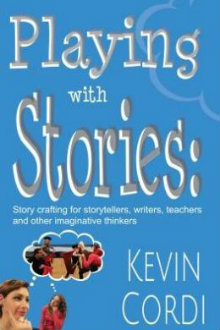How Playing with Stories Helps Us Learn
Playing with Stories: Story crafting for storytellers, writers, teachers and other imaginative thinkers
By Kevin Cordi
(Parkhurst Brothers Publishers, 2014 – Learn more)

This is the book for those in love with stories and those who believe that we “think in story.” Kevin Cordi gives strategies for building stories solo, with a partner or in small groups or “ensembles.”

The guide or mentor actually enters the story. To do this, we need to change our habits and thoughts. For example, “narratives are meant to be messy,” says Cordi. This “messiness” can start in the middle, and we have to be able to allow our work to be seen in progress.
Teachers and others will find specific strategies and examples in Cordi’s book. “Word Dancing” is one strategy, which is using words without writing them down and without judgment. Forget scripts. The process, not just the product, is important.
In talking stories out loud we can discover development. After all, he asks, since our first storytelling method was oral, why do we always go to a desk to write down our stories? We need to take “oral risks” and vocalize our work.
One method I think students of all ages will enjoy is taking the “bare bones” of a story like “Jack and the Beanstalk” and adding a character like Jim, the giant’s brother. What new story or stories might emerge?
Much more than the spoken word
Cordi quotes aphorisms (“When the music changes, so does the dance”) and experts. A great many ideas (“side coaching”) are taken from drama practitioners like Dorothy Heathcote. He asks that we not separate the arts. Use dance, puppetry, plays, music, poetry, journaling, or drawing.
Questions can also create narrative building blocks. They can help us get to the MIT (Most Important Thing) in a story. He emphasizes the importance of deep listening and devotes much of the book to encouraging us to be good listeners in order to coach or mediate stories along.
Once it’s time for the listener to respond, Cordi gives tips on specific questions. He discusses how trouble is important in story (it “elevates the story” and is the “engine of narrative”) and suggests ways to increase or decrease trouble.
All of this takes practice and trust. I particularly like how Cordi discusses how these methods can go beyond the classroom. Writers clubs and critique groups can use these methods, and someone who is a “story caretaker” can even coach someone who has a story over the phone or on the computer.
The author shares his own website and suggests other organizations involved in storytelling for more ideas. Reading Cordi’s methods, he has convinced me that “a story can morph in ways no one foresees.” His is a call to play and work with others in the formation and re-creation of our stories, and I will recommend his book to all those I know involved in story making.
Telling stories among the Standards
The author, to his credit, acknowledges that some teachers in our schools might be reluctant to take time away from what is not explicitly in the standards. Cordi would like to see his methods used in more than the English classroom and describes a history teacher simulating the journey on The Oregon Trail.
Some of these methods were tried in the 1970’s and 80’s and then dropped because they do take more time. But if we look closely at the standards, we can justify these means to reaching them in a more fun, memorable and lasting way. Stories can make a difference in our lives and education.
Take the “Permission 2 Play Pledge” written by Cordi, and see the generous bibliography for further study.
Permission 2 Play Pledge
I give myself permission
To have fun.
To take risks.
To make mistakes.
To Play
with my thinking
my choices
my direction and development,
to suspend
what I know
so
I know more
I give myself
permission
to
fail, succeed, and play again.
I have the right to shape
my stories.
I am the crafter and creator.
I am imaginative and supportive.
I know through
play
we understand our stories
and our stories become
alive
I give myself
permission to Play.
Mary Langer Thompson’s articles, short stories, and poetry appear in various journals and anthologies. She is a contributor to The Working Poet (Autumn Press) and Women and Poetry: Tips on Writing, Teaching and Publishing by Successful Women Poets (McFarland). She is a retired school principal and a proud member of the California Writers Club, High Desert Branch. Her first collection of poems, poems in water, was published in July 2014.


































